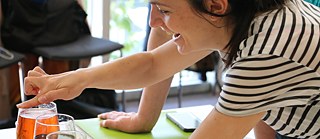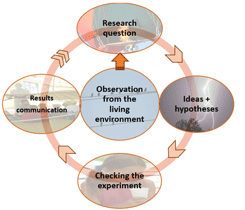Experiments in GFL lessons
How does a hot air balloon fly?

Scientific experiments bring GFL lessons to life. They inspire the curiosity of learners and encourage their thirst for knowledge. With this approach, learners can experiment in your lessons without losing out on the GFL curriculum.
Learning leads to understanding via people’s own experiences. Learners achieve cognitive success by discovering and understanding simple scientific or technical relationships. These relationships can also be visualised in German lessons through simple experiments, and the positive learning experience associated with this motivates learners to express their findings in the foreign language as well. This enriches the German lessons.
Target group for experiments in language lessons
Teachers can carry out scientific experiments from language level A2 onwards. It doesn’t matter whether the students are children, teenagers or adults. However, a clever choice of experiments is essential. The thing is, learners are able to assimilate scientific relationships at a cognitive level, even if they are not (yet) able to explain them in German. Their verbal and/or nonverbal reactions provide the teacher with feedback as to whether they have understood the German instructions and technical content.Choice of experiments
Teachers should avoid demonstration experiments in GFL lessons if possible. They should choose experiments that learners can perform in small groups. Group work encourages learners to discuss the research question, their solution ideas, the experiment and the results. With language beginners, that will still be happening in their native language to some extent. But the teacher has the opportunity to address the groups in German one by one, thereby providing them with individual support.
Furthermore teachers should consider which scientific or technical questions can be answered with the experiment, and how that fits in with the theme of the German lesson.
| Typical themes in German lessons | Sample research questions |
|---|---|
| Travel | Why does a hot air balloon fly? How does a rocket fly? |
| Seasonal celebrations | Why does a lake freeze from top to bottom? Why does a Christmas pyramid rotate? |
| Weather and the environment | Why should you not have a bath during a thunderstorm? What is the greenhouse effect? |
| Orientation | When is there a full moon? How do you get your bearings at sea? |
Incorporating the experiments into the lessons

A research question arises from this introductory situation. This research question constitutes the central object of investigation. The learners develop ideas as to how this research question could be answered. For this, teachers could offer various alternatives to function as scaffolding depending on language level, or they could invite the learners to discuss freely. The experiment checks these ideas. It’s important that learners discuss the results after that, and work through the experiment in language terms. One possibility is for the results to lead to a new research question and continuation of the experiments.
8 steps for preparation
- Look closely at the subject areas of your GFL curriculum and find some scientific references.
- Carry out research in experimentation books and websites to find a suitable experiment.
- Look for a link with the theme: what research question could answer this experiment? And how does this research question fit in with your learning theme?
- Try out the experiment!
- Consider what vocabulary and grammatical constructions could be given in advance, worked on or practised with this experiment (for example comparisons or comparative forms).
- Look for suitable activities to teach the vocabulary and grammar in a variety of contexts.
- Formulate learning goals for this learning unit.
- Develop opportunities to continue and expand on the theme.
Literature
Stuchtey, Sonja (2014): Das große Forscherbuch für Kinder. Würzburg: Arena Verlag.
Stuchtey, Sonja/Bäuerle, Patrick (2011): Das große Forscherbuch vom Körper. Würzburg: Arena Verlag.
Schettler, Heike (2017): Das große Forscherbuch für Grundschulkinder. Würzburg: Arena Verlag.